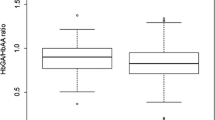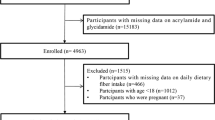Abstract
Objective
Acrylamide, a probable human carcinogen, is formed during high-heat cooking of many common foods. The validity of food frequency questionnaire (FFQ) measures of acrylamide intake has not been established. We assessed the validity of acrylamide intake calculated from an FFQ using a biomarker of acrylamide exposure.
Methods
We calculated acrylamide intake from an FFQ in the Nurses’ Health Study II. We measured hemoglobin adducts of acrylamide and its metabolite, glycidamide, in a random sample of 342 women. Correlation and regression analyses were used to assess the relationship between acrylamide intakes and adducts.
Results
The correlation between acrylamide intake and the sum of acrylamide and glycidamide adducts was 0.31 (95% CI: 0.20–0.41), adjusted for laboratory batch, energy intake, and age. Further adjustment for BMI, alcohol intake, and correction for random within-person measurement error in adducts gave a correlation of 0.34 (CI: 0.23–0.45). The intraclass correlation coefficient for the sum of adducts was 0.77 in blood samples collected 1–3 years apart in a subset of 45 women. Intake of several foods significantly predicted adducts in multiple regression.
Conclusions
Acrylamide intake and hemoglobin adducts of acrylamide and glycidamide were moderately correlated. Within-person consistency in adducts was high over time.


Similar content being viewed by others
References
IARC(1994) Monographs on the evaluation of carcinogenic risks to humans, Vol 60
International Programme on Chemical Safety. Acrylamide (EHC 49, 1985). Available at: www.inchem.org
Tareke E, Rydberg P, Karlsson P, Eriksson S, Törnqvist M (2002) Analysis of acrylamide, a carcinogen formed in heated foodstuffs. J Agric Food Chem 50(17):4998–5006. doi:10.1021/jf020302f
Mucci LA, Dickman PW, Steineck G, Adami HO, Augustsson K (2003) Dietary acrylamide and cancer of the large bowel, kidney, and bladder: absence of an association in a population-based study in Sweden. Br J Cancer 88(1):84–89. doi:10.1038/sj.bjc.6600726
Mucci LA, Lindblad P, Steineck G, Adami HO (2004) Dietary acrylamide and risk of renal cell cancer. Int J Cancer 109(5):774–776. doi:10.1002/ijc.20011
Mucci LA, Sandin S, Balter K, Adami HO, Magnusson C, Weiderpass E (2005) Acrylamide intake and breast cancer risk in Swedish women. JAMA 293(11):1326–1327. doi:10.1001/jama.293.11.1326
Mucci LA, Adami HO, Wolk A (2006) Prospective study of dietary acrylamide and risk of colorectal cancer among women. Int J Cancer 118(1):169–173. doi:10.1002/ijc.21309
Pelucchi C, Franceschi S, Levi F, Trichopoulos D, Bosetti C, Negri E et al (2003) Fried potatoes and human cancer. Int J Cancer 105(4):558–560. doi:10.1002/ijc.11118
Pelucchi C, Galeone C, Levi F, Negri E, Franceschi S, Talamini R et al (2006) Dietary acrylamide and human cancer. Int J Cancer 118(2):467–471. doi:10.1002/ijc.21336
Pelucchi C, Galeone C, Dal Maso L, Talamini R, Montella M, Ramazzotti V et al (2007) Dietary acrylamide and renal cell cancer. Int J Cancer 120(6):1376–1377. doi:10.1002/ijc.22457
Hogervorst JG, Schouten LJ, Konings EJ, Goldbohm RA, van den Brandt PA (2007) A prospective study of dietary acrylamide intake and the risk of endometrial, ovarian, and breast cancer. Cancer Epidemiol Biomarkers Prev 16(11):2304–2313. doi:10.1158/1055-9965.EPI-07-0581
Stadler RH, Scholz G (2004) Acrylamide: an update on current knowledge in analysis, levels in food, mechanisms of formation, and potential strategies of control. Nutr Rev 62(12):449–467. doi:10.1301/nr.2004.janr.449-467
Wirfält E, Paulsson B, Törnqvist M, Axmon A, Hagmar L (2008) Associations between estimated acrylamide intakes, and hemoglobin AA adducts in a sample from the Malmo Diet and Cancer cohort. Eur J Clin Nutr 62(3):314–323
Bjellaas T, Olesen PT, Frandsen H, Haugen M, Stolen LH, Paulsen JE et al (2007) Comparison of estimated dietary intake of acrylamide with hemoglobin adducts of acrylamide and glycidamide. Toxicol Sci 98(1):110–117. doi:10.1093/toxsci/kfm091
Kütting B, Uter W, Drexler H (2008) The association between self-reported acrylamide intake and hemoglobin adducts as biomarkers of exposure. Cancer Causes Control 19(3):273–281
Bergmark E, Calleman CJ, He F, Costa LG (1993) Determination of hemoglobin adducts in humans occupationally exposed to acrylamide. Toxicol Appl Pharmacol 120(1):45–54. doi:10.1006/taap.1993.1085
Törnqvist M, Fred C, Haglund J, Helleberg H, Paulsson B, Rydberg P (2002) Protein adducts: quantitative and qualitative aspects of their formation, analysis and applications. J Chromatogr B Analyt Technol Biomed Life Sci 778(1–2):279–308. doi:10.1016/S1570-0232(02)00172-1
U.S. Food and Drug Administration. Survey Data on Acrylamide in Food: Individual Food Products, 2002–2004. 2006; Available at: http://www.cfsan.fda.gov/~dms/acrydata.html
U.S. Food and Drug Administration (2006) Survey Data on Acrylamide in Food: Total Diet Study Results, 2003–2006
U.S. Food and Drug Administration. The 2006 Exposure Assessment for Acrylamide. 2006; Available at: http://www.cfsan.fda.gov/~dms/acryexpo.html
Rosén J, Nyman A, Hellenäs KE (2007) Retention studies of acrylamide for the design of a robust liquid chromatography-tandem mass spectrometry method for food analysis. J Chromatogr A 1172(1):19–24. doi:10.1016/j.chroma.2007.09.050
Wenzl T, Karasek L, Rosen J, Hellenaes KE, Crews C, Castle L et al (2006) Collaborative trial validation study of two methods, one based on high performance liquid chromatography-tandem mass spectrometry and on gas chromatography-mass spectrometry for the determination of acrylamide in bakery and potato products. J Chromatogr A 1132(1–2):211–218. doi:10.1016/j.chroma.2006.07.007
Vesper HW, Ospina M, Meyers T, Ingham L, Smith A, Gray JG et al (2006) Automated method for measuring globin adducts of acrylamide and glycidamide at optimized Edman reaction conditions. Rapid Commun Mass Spectrom 20(6):959–964. doi:10.1002/rcm.2396
Vesper HW, Bernert JT, Ospina M, Meyers T, Ingham L, Smith A et al (2007) Assessment of the relation between biomarkers for smoking and biomarkers for acrylamide exposure in humans. Cancer Epidemiol Biomarkers Prev 16(11):2471–2478. doi:10.1158/1055-9965.EPI-06-1058
Willett WC (1998) Nutritional epidemiology. Oxford University Press, New York
Rosner B, Willett WC (1988) Interval estimates for correlation coefficients corrected for within-person variation: implications for study design and hypothesis testing. Am J Epidemiol 127(2):377–386
Bergmark E (1997) Hemoglobin adducts of acrylamide and acrylonitrile in laboratory workers, smokers and nonsmokers. Chem Res Toxicol 10(1):78–84. doi:10.1021/tx960113p
Hagmar L, Wirfalt E, Paulsson B, Törnqvist M (2005) Differences in hemoglobin adduct levels of acrylamide in the general population with respect to dietary intake, smoking habits and gender. Mutat Res 580(1–2):157–165
Schettgen T, Rossbach B, Kutting B, Letzel S, Drexler H, Angerer J (2004) Determination of haemoglobin adducts of acrylamide and glycidamide in smoking and non-smoking persons of the general population. Int J Hyg Environ Health 207(6):531–539. doi:10.1078/1438-4639-00324
Schettgen T, Weiss T, Drexler H, Angerer J (2003) A first approach to estimate the internal exposure to acrylamide in smoking and non-smoking adults from Germany. Int J Hyg Environ Health 206(1):9–14. doi:10.1078/1438-4639-00195
Aureli F, Di Pasquale M, Lucchetti D, Aureli P, Coni E (2007) An absorption study of dietary administered acrylamide in swine. Food Chem Toxicol 45(7):1202–1209. doi:10.1016/j.fct.2006.12.029
Doerge DR, Young JF, McDaniel LP, Twaddle NC, Churchwell MI (2005) Toxicokinetics of acrylamide and glycidamide in Fischer 344 rats. Toxicol Appl Pharmacol 208(3):199–209. doi:10.1016/j.taap.2005.03.003
Doerge DR, Young JF, McDaniel LP, Twaddle NC, Churchwell MI (2005) Toxicokinetics of acrylamide and glycidamide in B6C3F1 mice. Toxicol Appl Pharmacol 202(3):258–267. doi:10.1016/j.taap.2004.07.001
Besaratinia A, Pfeifer GP (2004) Genotoxicity of acrylamide and glycidamide. J Natl Cancer Inst 96(13):1023–1029
Manjanatha MG, Aidoo A, Shelton SD, Bishop ME, McDaniel LP, Lyn-Cook LE et al (2006) Genotoxicity of acrylamide and its metabolite glycidamide administered in drinking water to male and female Big Blue mice. Environ Mol Mutagen 47(1):6–17. doi:10.1002/em.20157
Calleman CJ, Bergmark E, Stern LG, Costa LG (1993) A nonlinear dosimetric model for hemoglobin adduct formation by the neurotoxic agent acrylamide and its genotoxic metabolite glycidamide. Environ Health Perspect 99:221–223. doi:10.2307/3431486
Vesper HW, Licea-Perez H, Meyers T, Ospina M, Myers GL (2005) Pilot study on the impact of potato chips consumption on biomarkers of acrylamide exposure. Adv Exp Med Biol 561:89–96
Acknowledgments
This work was supported by a grant from the National Cancer Institute, CA050385. KMW is partially supported by NCI/NIH Training Grant T32 CA09001.
Author information
Authors and Affiliations
Corresponding author
Rights and permissions
About this article
Cite this article
Wilson, K.M., Vesper, H.W., Tocco, P. et al. Validation of a food frequency questionnaire measurement of dietary acrylamide intake using hemoglobin adducts of acrylamide and glycidamide. Cancer Causes Control 20, 269–278 (2009). https://doi.org/10.1007/s10552-008-9241-7
Received:
Accepted:
Published:
Issue Date:
DOI: https://doi.org/10.1007/s10552-008-9241-7




